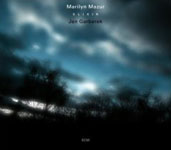Home » Jazz Articles » Album Review » Marilyn Mazur: Elixir
Marilyn Mazur: Elixir
Garbarek appears on only half the album, however, and while his ever- present attention to tone and melody over pyrotechnics remains definitive, it's Mazur's multiplicity of percussion instruments—a global cross-section ranging from marimba, bowed vibraphone, waterphone and hang to bells, gongs, cymbals, magic, log and udu drums, sheep bells, Indian cowbells and more—that define Elixir's surprisingly spare and often hypnotic soundscape. The album is diametrically opposed to freely improvised albums like the flat-out sonic assault of John Coltrane's Interstellar Space (Impulse!, 1967). Instead, Mazur—alone and with Garbarek—develops a series of pieces ranging from rhythmic pan-culturalism to out-of- time textural explorations.
It may seem incongruous that an album largely focused on percussion can be soothing and meditative but, with Mazur and Garbarek's attention to detail rather than density and ECM producer Manfred Eicher's typically astute sequencing of the material, the undeniably spartan Elixir remains equally an unmistakably musical and accessible experience. By focusing individual pieces on either a single instrument or a small group of them it's an educational one too, leaving a lasting impression that will heighten the appreciation of other albums with percussion sourced from around the world.
When Mazur and Garbarek collaborate, the closest reference points are some of the saxophonist's own releases, including Eventyr (ECM, 1980) and Legend of the Seven Dreams (ECM 1988), which both relied heavily on his own cultural roots. Far from conventional jazz, Elixir is, instead, an album that looks deep into the heart of folk music for its inspiration. "Winter Wish" invokes images of solitude in icy landscapes, while "Spirit of the Air," with Garbarek on flute and Mazur utilizing a range of bell-like percussion instruments, is feather-light and ethereal. "Spirit of the Sun" is more propulsive, with Garbarek again on flute but Mazur's hand drums creating a warmer and more pulse- driven ambience.
While Mazur's other recordings, including Circular Chant (Storyville, 1994), Story of Multiplicity (Da Capo, 1998) and, of course, Small Labyrinths, were all ensemble affairs where percussion was part of a much larger whole, Elixir finds Mazur at her most intimate. Whether engaged in monologue or dialogue, it's an album of surprising depth, honesty and humanity.
Track Listing
Clear; Pathway; Dunun Song; Joy Chant; Bell-Painting; Elixir; Orientales; Metal Drew; Mother Drum; Mountain Breath; Creature Walk; Spirit of Air; Spirit of Sun; Sheep Dream; Talking Wind; Totem Dance; The Siren in the Well; River; On the Move; Winter Wish; Clear Recycle.
Personnel
Marilyn Mazur
percussionMarilyn Mazur: percussion; Jan Garbarek: tenor and soprano saxophones, flute.
Album information
Title: Elixir | Year Released: 2008 | Record Label: ECM Records
< Previous
Playful Virtuosity
Next >
Book of Velocities
Comments
About Marilyn Mazur
Instrument: Percussion
Related Articles | Concerts | Albums | Photos | Similar ToTags
For the Love of Jazz
 All About Jazz has been a pillar of jazz since 1995, championing it as an art form and, more importantly, supporting the musicians who create it. Our enduring commitment has made "AAJ" one of the most culturally important websites of its kind, read by hundreds of thousands of fans, musicians and industry figures every month.
All About Jazz has been a pillar of jazz since 1995, championing it as an art form and, more importantly, supporting the musicians who create it. Our enduring commitment has made "AAJ" one of the most culturally important websites of its kind, read by hundreds of thousands of fans, musicians and industry figures every month.



















